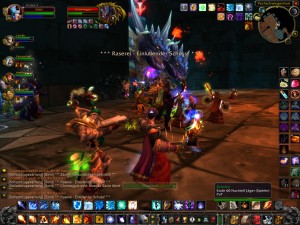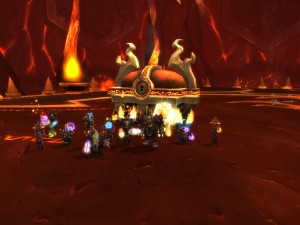Guild size
During my ongoing literature review I often discover interesting facts about things I’ve never thought about. Sometimes I can connect these facts with my own observations: The result is mostly a completely new idea why things are as they are. Maybe these ideas are new to you, too. Therefore I’ll share my new science based knowledge with you!
This week: I read the paper „The life and death of online gaming communities: a look at guilds in world of warcraft“ [1]. The authors investigated the group dynamics and social networks in virtual worlds. During gameplay players are often experiencing the „necessity of grouping“ [2]: Most of the endgame content isn’t doable alone, therefore players need to form a group in order to achieve these difficult goals. If the players are like-minded they can also form a persistent group: a guild.
This „finding of the week“ is all about the guild size results found in this investigation and the recommendations the authors made.
The results of this paper have shown that 90% of the existing guilds are formed by a maximum of 35 members. In classic-WoW most of the end-game raid instances were designed for a group of 40 players. Considering these two facts, most of the guilds had to form alliances with other guilds to be able to tackle the 40-men raid instances.
I’ve experienced the same during my classic-WoW raiding time: I was in a guild that was in an alliance with several other guilds. But until I’ve read this paper [1] I was never considering this situation as a WoW-wide issue or even as an issue in general.
I had a lot of friends playing in guilds with more than 40 members and our way of forming an alliance was a good way to achieve raiding goals. It was even a more epic feeling: You need to form huge groups consisting of several guilds to fight the evil forces. Additionally there were enough other content like 5- oder 10-men intances which could be solved by players of a the same guild.
The paper also gives an overview about the solutions and adaptations Blizzard has implemented allowing almost every guild to complete a raid instance: After the release of the first WoW addon „The Burning Crusade“ (2007) most of the end-game raid instances were designed for only 25 players – Karazhan and Zul’Aman were even 10-men instances. The second addon „Wrath of the Lich King“ (2008) implemented the option to choose between 10- and 25-men difficulty.
It’s an interesting fact that players of a MMORGP are mostly enjoying small groups. Although the game is played by masses of players the same time, the majority of people only have few fellows. As already mentioned in the paper [1], this result might indicate a limit of group size – humans can only have a certain amount of stable relationships the same time [3] – in online spaces.
Finally the results gave me an additional point of view: It was not only the difficulty of getting 40 player online the same time or the hard work of finding 40 like-minded players which caused the development of the much smaller instances. This research has shown that Blizzard’s changes align with the limit of group size in online spaces. It’s also fascinating how games like WoW are offering a social environment which is allowing real group dynamics.
References
[1] Ducheneaut, Nicolas; Yee, Nick; Nickell, Eric; Moore, Robert J. (2007): The life and death of online gaming communities: a look at guilds in world of warcraft, in: CHI 2007 Proceedings of the SIGCHI conference on Human factors in computing systems, pp. 839 – 848.
[2] Yee, Nick (2009): Befriending Ogres and Wood-Elves: Relationship Formation and The Social Architecture of Norrath, in: Game Studies, 9 (1).
[3] Dunbar, R. I. M. (1993): Coevolution of neocortical size, group size and language in humans, in: Behavioral and brain sciences, 16 (4), pp. 681 – 735.

